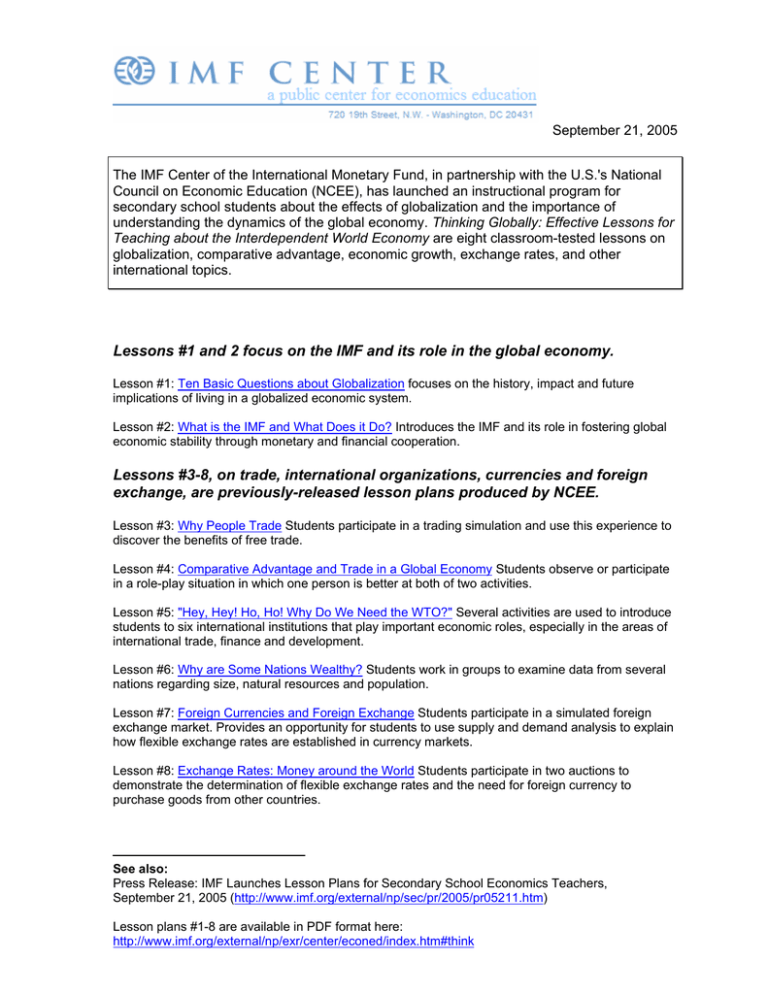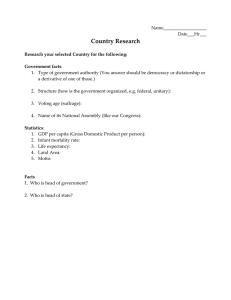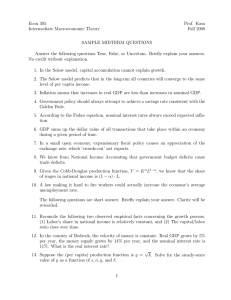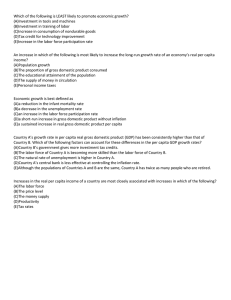Thinking Globally: Effective Lessons for Teaching About
advertisement

September 21, 2005 The IMF Center of the International Monetary Fund, in partnership with the U.S.'s National Council on Economic Education (NCEE), has launched an instructional program for secondary school students about the effects of globalization and the importance of understanding the dynamics of the global economy. Thinking Globally: Effective Lessons for Teaching about the Interdependent World Economy are eight classroom-tested lessons on globalization, comparative advantage, economic growth, exchange rates, and other international topics. Lessons #1 and 2 focus on the IMF and its role in the global economy. Lesson #1: Ten Basic Questions about Globalization focuses on the history, impact and future implications of living in a globalized economic system. Lesson #2: What is the IMF and What Does it Do? Introduces the IMF and its role in fostering global economic stability through monetary and financial cooperation. Lessons #3-8, on trade, international organizations, currencies and foreign exchange, are previously-released lesson plans produced by NCEE. Lesson #3: Why People Trade Students participate in a trading simulation and use this experience to discover the benefits of free trade. Lesson #4: Comparative Advantage and Trade in a Global Economy Students observe or participate in a role-play situation in which one person is better at both of two activities. Lesson #5: "Hey, Hey! Ho, Ho! Why Do We Need the WTO?" Several activities are used to introduce students to six international institutions that play important economic roles, especially in the areas of international trade, finance and development. Lesson #6: Why are Some Nations Wealthy? Students work in groups to examine data from several nations regarding size, natural resources and population. Lesson #7: Foreign Currencies and Foreign Exchange Students participate in a simulated foreign exchange market. Provides an opportunity for students to use supply and demand analysis to explain how flexible exchange rates are established in currency markets. Lesson #8: Exchange Rates: Money around the World Students participate in two auctions to demonstrate the determination of flexible exchange rates and the need for foreign currency to purchase goods from other countries. See also: Press Release: IMF Launches Lesson Plans for Secondary School Economics Teachers, September 21, 2005 (http://www.imf.org/external/np/sec/pr/2005/pr05211.htm) Lesson plans #1-8 are available in PDF format here: http://www.imf.org/external/np/exr/center/econed/index.htm#think Unit 7 Unit 7 Lesson 43 T E A C H E R ’ S G U I D E C O N T E N T S TA N D A R D Why Are Some Nations Wealthy? • INTRODUCTION Economics The contentious debate on globalization often centers on why some nations are rich and others remain in poverty. A nation’s wealth affects the standard of living of its citizens. The key to economic prosperity is long-term economic growth. What explains the differences among nations in long-term economic growth? Economists have identified the keys to economic growth; they include technological innovation, investment in physical and human capital, low inflation, political stability, and a decentralized market economy. Reasoning The anti-globalization movement is a major threat to world prosperity. According to Steven Landsburg, “the particular responses endorsed by the anti-globalization crowd — kick back, relax, keep your environment clean and don’t worry so much about where your next meal is coming from — are responses that have never worked well for poor people in the U.S. or anywhere else” (The Wall Street Journal, July 23, 2001). Investment in factories, machinery, new technology, and the health, education, and training of people can raise future standards of living. (NCEE Content Standard 15) LESSON DESCRIPTION Students work in groups to examine data from several nations regarding size, natural resources, and population. Using these data, they try to identify the nations and predict whether each nation is rich or poor. Students rank the nations from richest to poorest. After the mystery nations are revealed, students discuss economists’ findings about the factors that contribute most to long-term economic growth. Time Required: 45 minutes M AT E R I A L S • • A transparency of Visuals 1, 2, 3, and 4 Activity 1 The way to achieve economic growth is to create incentives to save, invest, and innovate. Every year the Heritage Foundation and The Wall Street Journal publish the “Index of Economic Freedom.” Every year the findings are similar. Countries with the most economic freedom (low taxes, less government regulation, sound monetary policy, protection of property rights, decentralized markets) also have the highest rates of economic growth. PROCEDURE 1. Explain that in this lesson the students will predict which nations of the world are wealthy and which are not, using data on different nations’ size, natural resources, and population. 2. Divide the class into groups of three. 3. Refer the groups to Activity 1; ask the students to identify the nations and then rank them from richest to poorest. CONCEPTS 4. • • • • • • • • Have each group report its findings to the class. Discuss why they ranked the countries as they did. (Most will focus on the amount of natural resources the nations possess.) 5. Use Visual 1 to reveal the mystery nations and go over the answers for Activity 1. Economic growth Human capital Natural resources Physical capital Productivity Property rights Saving and investment policy Trade Answers to Activity 1 Richest Country Letter Country Name 1. E Singapore OBJECTIVES 2. B Japan Students will: 3. A Argentina 1. 4. D Russia 5. C Nigeria 2. Predict factors associated with national long-term economic growth and prosperity. Poorest Explore the relationship between economic growth and the factors commonly associated with market economies, including property rights, institutions promoting saving and investing in human capital and physical capital, and free trade. C A P S T O N E : E X E M P L A RY L E S S O N S FOR H I G H S C H O O L E C O N O M I C S @ N AT I O N A L C O U N C I L ON E C O N O M I C E D U C AT I O N , N E W Y O R K , NY 281 W H Y A R E S O M E N AT I O N S W E A LT H Y ? 6. 7. 8. Have the students answer the following questions, but do not comment on their answers until everyone has had a chance to answer. 10. Display Visual 4. Explain that these are the most repressed nations. Note that these nations are not only poor but are incubators of terrorism. • How can some nations with few natural resources, such as Japan and Singapore, be relatively wealthy? 11. Display Visual 2 again and discuss the remaining bullet points: • How can other nations with vast amounts of natural resources, such as Nigeria and Russia, be relatively poor? Explain that some economists call this problem “the natural resources paradox.” Natural resources have certainly contributed to the economic success of some nations, including the United States, South Africa, and the oil-rich nations of the Middle East. But there are many examples of nations such as Japan and Singapore that have achieved great economic success with relatively few natural resources. And some nations with vast stocks of natural resources, such as Nigeria and Russia, remain relatively poor. Ask the students to list other factors that might promote or discourage long-term economic growth and high standards of living. 282 Strong incentives to save, invest, and increase productivity. Successful economies have institutions that encourage saving and investment. Saving means not spending all of the nation’s income for the current consumption of goods and services. Resources that are consumed today can’t be used for investment, and vice versa. Successful investments lead to higher future levels of production, income, and consumption. • Competitive markets. Competitive markets generate innovation and lower prices. • Low inflation. A stable currency (low levels of inflation) enhances incentives by maintaining the value of financial assets, which encourages saving and investment. Preventing inflation also keeps people’s efforts directed at work, saving, and investing, rather than searching for ways to protect their assets from the effects of inflation. • Political stability. Political stability means a change in government won’t cause confiscation of its citizens’ property. There is an incentive for long-term investment. • Free trade. The high-income nations of the world are heavily involved in world trade — and, in fact, the United States is both the wealthiest nation in the world and the world’s largest trader. Canada, Germany, the United Kingdom, Japan, France, Singapore, and Hong Kong are also heavily engaged in international trade. Trading leads nations to specialize in the production and export of the goods and services they can produce at the lowest opportunity cost. Trading those exports for other products that can be produced at a lower cost in other nations reduces the total cost of production and allows higher levels of consumption worldwide. Free trade also results in increased competition, which keeps prices lower for consumers and helps insure that businesses are responsive to consumer demand. Levels of trade have increased dramatically over the past 25 years. As much as one-third of U.S. economic growth during the 1990s was attributed to the international trade sector of the economy. Nevertheless, international trade is controversial because it adversely affects businesses that must compete with foreign producers. Display Visual 2 and discuss the major points: • 9. • High investment levels in physical and human capital. Investments in both physical capital (factories and machines) and human capital (the health, education, and training of workers) promote long-term economic growth. • Both are also related to the widespread use of new technologies, which often require new machinery and training of workers. Over the past two centuries, technological innovations have been the single most important determinant of economic growth, followed closely by investments in physical and human capital. • Wealthier nations are usually in a better position to fund additional investments in human and physical capital, but less developed nations often present other opportunities for new investments. For example, lower levels of income mean that labor costs are lower in those nations, and it is often possible to transfer new technologies and production methods from wealthier nations to the poorer nations. • Greater economic freedom. Display Visual 3. Explain that countries with the highest levels of economic freedom have higher rates of long-term economic growth. Note on Visual 3 the freest nations economically in 2002. Note that these nations are rich or have high levels of economic growth. C A P S T O N E : E X E M P L A RY L E S S O N S FOR H I G H S C H O O L E C O N O M I C S @ N AT I O N A L C O U N C I L ON E C O N O M I C E D U C AT I O N , N E W Y O R K , NY Unit 7 CLOSURE T E A C H E R ’ 3. What do we mean by “investment in human capital”? S G U I D E Ask the following questions. A. Higher spending on education and training • B. Higher spending on population control measures How important are natural resources to a nation’s wealth? (Natural resources have certainly contributed to the economic success of some nations. But there are many examples of nations and regions, such as Japan and Hong Kong, that have achieved great economic success with very few natural resources.) • What are the major factors that encourage long-term economic growth? (Successful economies encourage greater productivity through investments in physical capital, human capital, and technology; control inflation and maintain political stability; experience moderate but not rapid population growth; encourage international trade; and provide strong financial incentives and protect property rights, which encourage people to work, save, and invest in themselves and in business opportunities. Over the past century, the nations with the greatest economic growth were those that adopted the key characteristics of a market economy.) • How does per capita GDP relate to the quality of life? Why is this important? (The higher the per capita GDP, the higher the quality of life. Nations with a high per capita GDP have high literacy rates, low infant mortality rates, and long life expectancies. Successful economies provide their citizens with a higher quality of life.) M U LT I P L E - C H O I C E Q U E S T I O N S (CORRECT 1. C. Government spending on exploration of natural resources D. All of the above E S S AY Q U E S T I O N S 1. President Bush claims that “when we negotiate for open markets, we are providing new hope for the world’s poor.” Does freer trade help or hurt the world’s poor? (By allowing nations, organizations, and individuals to specialize in what they do best, trade makes more goods and services available to everyone, raising living standards to all. Freer trade also increases competition, spreads knowledge and skills, and provides for the transfer of technology. These factors increase living standards.) 2. What factors most increase the wealth of a nation? (Students should emphasize the factors listed on Visual 2.) 3. What do we mean by “economic freedom,” and how does it relate to economic growth? (Economic freedom means that people can make economic decisions without restrictions from government. Economic freedom involves low taxes, less government regulation, protection of property rights, freedom of enterprise, and a commitment to free trade. Greater economic freedom correlates strongly with greater economic growth.) ANSWERS SHOWN IN BOLD) Which of the following factors contributes least to economic growth? A. Greater economic freedom B. Large amounts of natural resources C. Low rates of inflation D. High investment in physical and human capital 2. Greater economic freedom is associated with: A. Lower life expectancy. B. Terrorism. C. Political repression. D. Greater economic growth. C A P S T O N E : E X E M P L A RY L E S S O N S FOR H I G H S C H O O L E C O N O M I C S @ N AT I O N A L C O U N C I L ON E C O N O M I C E D U C AT I O N , N E W Y O R K , NY 283 W H Y A R E S O M E N AT I O N S W E A LT H Y ? Unit 7, Lesson 43 Visual 1 MYSTERY NATIONS REVEALED* C O U N T RY A C O U N T RY D Name of country: Argentina Population: 37,384,816 Per capita GDP: $12,900 Life expectancy: 75.26 years Literacy rate: 96.2% Infant mortality rate: 17.75/1000 Name of country: Russia Population: 145,470,197 Per capita GDP: $7700 Life expectancy: 67.34 years Literacy rate: 98% Infant mortality rate: 20.05/1000 C O U N T RY B C O U N T RY E Name of country: Japan Population: 126,771,662 Per capita GDP: $24,900 Life expectancy: 80.8 years Literacy rate: 99% Infant mortality rate: 3.88/1000 Name of country: Singapore Population: 4,300,419 Per capita GDP: $26,500 Life expectancy: 83.35 years Literacy rate: 93.5% Infant mortality rate: 3.62/1000 C O U N T RY C Name of country: Nigeria Population: 126,635,626 Per capita GDP: $950 Life expectancy: 51.07 years Literacy rate: 57.1% Infant mortality rate: 73.34/1000 *All data from CIA World Factbook 2001, www.odci.gov. 284 C A P S T O N E : E X E M P L A RY L E S S O N S FOR H I G H S C H O O L E C O N O M I C S @ N AT I O N A L C O U N C I L ON E C O N O M I C E D U C AT I O N , N E W Y O R K , NY Unit 7 T E A C H E R ’ S G U I D E Unit 7, Lesson 43 Visual 2 FACTORS CONTRIBUTING TO LONG-TERM ECONOMIC GROWTH • High investment levels in physical and human capital • Greater economic freedom, including lower taxes, fewer government regulations, sound monetary policy, protection of property rights, and decentralized decision-making in most sectors of the economy • Strong incentives to save, invest, and increase productivity (including property rights) • Competitive markets • Low inflation • Political stability • Free trade C A P S T O N E : E X E M P L A RY L E S S O N S FOR H I G H S C H O O L E C O N O M I C S @ N AT I O N A L C O U N C I L ON E C O N O M I C E D U C AT I O N , N E W Y O R K , NY 285 W H Y A R E S O M E N AT I O N S W E A LT H Y ? Unit 7, Lesson 43 Visual 3 COUNTRIES WITH THE HIGHEST LEVELS OF ECONOMIC FREEDOM, 2002 1. Hong Kong 2. Singapore 3. New Zealand 4. Estonia Ireland Luxembourg Netherlands United States 9. Australia Chile United Kingdom 12. Denmark Switzerland 14. Finland 286 C A P S T O N E : E X E M P L A RY L E S S O N S FOR H I G H S C H O O L E C O N O M I C S @ N AT I O N A L C O U N C I L ON E C O N O M I C E D U C AT I O N , N E W Y O R K , NY Unit 7 T E A C H E R ’ S G U I D E Unit 7, Lesson 43 Visual 4 COUNTRIES WITH THE LOWEST LEVELS OF ECONOMIC FREEDOM, 2002 144. Yugoslavia 145. Burma Syria 147. Zimbabwe 148. Belarus Uzbekistan 150. Turkmenistan 151. Iran Laos 153. Cuba Libya 155. Iraq North Korea C A P S T O N E : E X E M P L A RY L E S S O N S FOR H I G H S C H O O L E C O N O M I C S @ N AT I O N A L C O U N C I L ON E C O N O M I C E D U C AT I O N , N E W Y O R K , NY 287 Unit 7 S T U D E N T A C T I V I T I E S Unit 7, Lesson 43 Unit 7, Lesson 43 Activity 1 Activity 1 Rich Nation/Poor Nation Rich Nation/Poor Nation Part 1. You are secret agents assigned to find out if a country is rich or poor. From the information provided below, identify each of the five countries listed. Jot down the country’s name opposite each bold-face heading. Part 2. Rank the five countries you have identified in order, with the richest country placed at “1” and the poorest country at “5.” Write the letter of the country used in the list above and the name of country. Country A __________________________________ Richest Country Letter Size: Three-tenths the size of the United States Country Name 1. ______________ _______________ Population: 37,000,000 (small for a nation this size) 2. ______________ _______________ Natural Resources: Rich resources with fertile land and minerals such as lead, zinc, tin, copper, iron ore, oil, and uranium 3. ______________ _______________ 4. ______________ _______________ 5. ______________ _______________ Country B __________________________________ Poorest Size: About the size of California Population: 127,000,000 Natural Resources: Fish, no mineral resources Country C __________________________________ Size: Twice the size of California Population: Large population of 127,000,000 Natural Resources: Vast resources including oil, tin, iron ore, coal, limestone, lead, zinc, and natural gas Country D __________________________________ Size: 1.8 times the size of the United States Population: 145,000,000 Natural Resources: Vast resources with major deposits of oil, natural gas, coal, many strategic minerals, vast timber supplies Country E___________________________________ Size: 3.5 times larger than Washington, D.C. Population: 4,000,000 Natural Resources: Fish, deepwater port C A P S T O N E : E X E M P L A RY L E S S O N S FOR H I G H S C H O O L E C O N O M I C S @ N AT I O N A L C O U N C I L ON E C O N O M I C E D U C AT I O N , N E W Y O R K , NY 111




